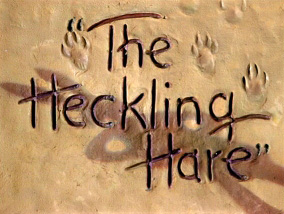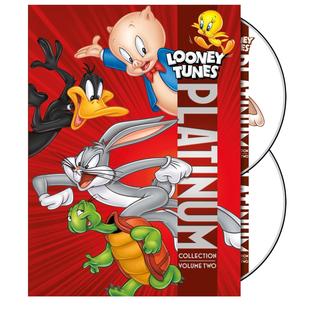
Bugs Bunny is a cartoon character created in the late 1930s at Warner Bros. Cartoons and voiced originally by Mel Blanc. Bugs is best known for his featured roles in the Looney Tunes and Merrie Melodies series of animated short films, produced by Warner Bros. Earlier iterations of the character first appeared in Ben Hardaway's Porky's Hare Hunt (1938) and subsequent shorts before Bugs's definitive characterization debuted in Tex Avery's A Wild Hare (1940). Bob Givens, Chuck Jones, and Robert McKimson are credited for defining Bugs's design.

Looney Tunes is an American animated franchise produced and distributed by Warner Bros. It began as a series of short films that originally ran from 1930 to 1969, along with its spin-off series Merrie Melodies, during the golden age of American animation. Following a revival in the late 1970s, new shorts were released as recently as 2014. The two series introduced a large cast of characters, including Bugs Bunny, Daffy Duck, and Porky Pig. The term Looney Tunes has since been expanded to also refer to the characters themselves.

Frederick Bean "Tex" Avery was an American animator, cartoonist, director, and voice actor. He was known for directing and producing animated cartoons during the golden age of American animation. His most significant work was for the Warner Bros. and Metro-Goldwyn-Mayer studios, where he was crucial in the creation and evolution of famous animated characters such as Bugs Bunny, Daffy Duck, Porky Pig, Elmer Fudd, Droopy, Screwy Squirrel, The Wolf, Red Hot Riding Hood, and George and Junior.

Droopy is an animated character from the golden age of American animation. He is an anthropomorphic white Basset Hound with a droopy face. He was created in 1943 by Tex Avery for theatrical cartoon shorts produced by the Metro-Goldwyn-Mayer cartoon studio. Essentially the polar opposite of Avery's other MGM character, the loud and wacky Screwy Squirrel, Droopy moves slowly and lethargically, speaks in a jowly monotone voice, and—though hardly an imposing character—is shrewd enough to outwit his enemies. When finally roused to anger, often by a bad guy laughing heartily at him, Droopy is capable of beating adversaries many times his size with a comical thrashing.
The Looney Tunes Golden Collection is a series of six four-disc DVD sets from Warner Home Video, each containing about 60 Looney Tunes and Merrie Melodies animated shorts originally released from the 1930s to 1960s. The initial run of the series was in folding cardboard packaging issued gradually from October 28, 2003 to October 21, 2008. A boxed set combining all six volumes was released in 2011, and each volume was reissued separately in standard Amaray-style cases in 2020.

Michael Maltese was an American screenwriter and storyboard artist for classic animated cartoon shorts. He is best known for working in the 1950s on a series of Merrie Melodies cartoons with director Chuck Jones. This collaboration produced many highly acclaimed animated shorts, including 4 of the top 5 "greatest cartoons" as judged by 1000 animation professionals; "What's Opera, Doc?" tops this list as the best animated short of all time.

A Wild Hare is a 1940 American animated comedy short film directed by Tex Avery, produced by Leon Schlesinger, and distributed by Warner Bros. as part of the Merrie Melodies series. The film was released on July 27, 1940, and features Elmer Fudd and Bugs Bunny, the latter making what is considered his first official appearance.

The Heckling Hare is a Merrie Melodies cartoon, released on July 5, 1941, and featuring Bugs Bunny and a dopey dog named Willoughby. The cartoon was directed by Tex Avery, written by Michael Maltese, animated by soon-to-be director Robert McKimson, and with musical direction by Carl W. Stalling. In a style that was becoming typical of the Bugs character, he easily outwitted and tormented his antagonist through the short, his only concern being what to do next to the dog.

All This and Rabbit Stew is a 1941 Merrie Melodies cartoon directed by Tex Avery. The cartoon was released on September 13, 1941, and features Bugs Bunny.
This is a list of all cartoons featuring Porky Pig. Directors are listed in parentheses.
Of Fox and Hounds is a 1940 Warner Bros. Merrie Melodies directed by Tex Avery. The short was released on December 7, 1940, and introduces Willoughby the Dog. Avery performed the voice of Willoughby, and Mel Blanc voiced George the Fox and the bear's yells. The short is an attempt to duplicate the success of the 1940 Bugs Bunny short A Wild Hare by giving another anthropomorphic animal the same unflappable demeanor. The names of Tex Avery, Dave Monohan, Carl W. Stalling, and possibly Charles McKimson intentionally draft numbers in the credits.

The Golden Age of Looney Tunes is a collection of LaserDiscs released by MGM/UA Home Video in the 1990s. There were five sets made, featuring a number of discs, and each disc side represented a different theme, being made up of seven cartoons per side. The first volume was also released on VHS, with each tape representing one disc side.

Elmer J. Fudd is an animated cartoon character in the Warner Bros. Looney Tunes/Merrie Melodies series and the archenemy of Bugs Bunny. His aim is to hunt Bugs, but he usually ends up seriously injuring himself and other antagonizing characters. He speaks in an unusual way, replacing his Rs and Ls with Ws, so he often refers to Bugs Bunny as a "scwewy" or "wascawwy (rascally) wabbit". Elmer's signature catchphrase is, "Shhh. Be vewy vewy quiet, I'm hunting wabbits", as well as his trademark laughter.
The character that would evolve into Bugs Bunny appeared in four cartoon shorts before his first official appearance in Tex Avery's A Wild Hare. While this early version is commonly referred to as "Happy Rabbit", animation historian David Gerstein disputes this, saying that the only usage of the term was from Mel Blanc himself; the name "Bugs Bunny" was used as early as April 1938, from a model sheet made by Charles Thorson which was used for the short Hare-um Scare-um. Bugs was also mentioned by name from an August 1939 review of the short in the Motion Picture Herald.

Foxy by Proxy is a 1952 Merrie Melodies cartoon directed by Friz Freleng. The short was released on February 23, 1952, and features Bugs Bunny and Willoughby the Dog, in the latter's last appearance. Mel Blanc voices Bugs Bunny, while an uncredited Stan Freberg voices Willoughby and one of the dogs that talks in the short. This cartoon is considered a remake to Of Fox and Hounds from 1940; in fact, the opening sequence was "borrowed" directly from the original.

Looney Tunes Platinum Collection: Volume 2 is a Blu-ray and DVD box set by Warner Home Video released on October 16, 2012. It contains 50 Looney Tunes and Merrie Melodies cartoons and numerous supplements. Disc 3 is exclusive to the Blu-ray version of the set. Unlike Volume 1, which was released in a digibook, Volume 2 was released in a standard 1 movie case. This release was followed by Looney Tunes Platinum Collection: Volume 3
Tex Avery Screwball Classics is a series of single-disc Blu-ray and DVD sets by Warner Bros. Home Entertainment's Warner Archive unit collecting various theatrical cartoons from animation director Tex Avery during his tenure at the Metro-Goldwyn-Mayer studio's cartoon division between the years of 1942 and 1955. It is the first comprehensive collection of Avery's MGM shorts to be released on home media in North America since The Compleat Tex Avery series of laserdiscs in the 1990s, with many of the shorts having been previously unreleased on DVD or Blu-ray.











